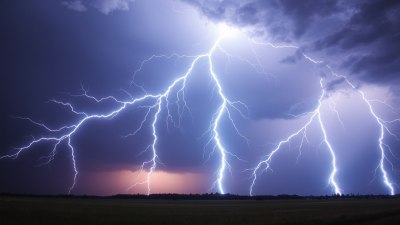Why Your Mood Has the Energy of a Snowstorm
Explore the complex relationship between mood and energy, unraveling why your emotions feel like a powerful snowstorm within.

Mood is a fascinating and complex emotional state that influences our perceptions, decisions, and overall well-being. Often, people describe their mood as having an energy, a palpable force that can be as calming as a gentle breeze or as intense as a snowstorm. But why exactly does your mood sometimes feel like the energy of a snowstorm? Understanding this phenomenon involves delving into the psychological, physiological, and environmental factors that shape how moods interact with our internal energy levels and external behavior.
The Nature of Mood and Emotional Energy
To comprehend why moods carry energy comparable to natural phenomena like snowstorms, it's essential to first understand what moods are. Unlike fleeting emotions, moods tend to be more prolonged and diffuse. They do not necessarily have a clear cause and can influence our thoughts and behavior over hours or even days. The energy of a mood refers to the intensity or activation level that the mood generates within us. High-energy moods can push us to act decisively or feel restless, while low-energy moods might cause lethargy or passiveness.
When we describe a mood as stormy or turbulent—like a snowstorm—we point to a heightened level of emotional intensity, confusion, or inner chaos. This condition can resemble the swirling, relentless nature of snowstorms, where the energy of the atmosphere seems uncontainable, shifting, and powerful. Just like a snowstorm can disrupt normal activity and transform the landscape, a stormy mood can profoundly change the terrain of our mind and behavior.
Psychological Mechanisms Behind Stormy Moods
The energy of a stormy mood arises from several psychological mechanisms. First, cognitive appraisal plays a critical role. How we interpret events affects our emotional experience. If we perceive situations as threatening, frustrating, or unpredictable, our mood can ramp up in intensity, creating a turbulent inner environment much like a snowstorm whipping up gusts and snow. This appraisal triggers heightened arousal and can lead to emotional overwhelm.
Anxiety and stress also contribute heavily to the storm-like qualities of mood. When the brain faces stressors, the hypothalamic-pituitary-adrenal (HPA) axis activates, releasing cortisol and other stress hormones. This neurochemical storm can flood the body and mind with energy but also anxiety, restlessness, and negative ruminations that reflect the chaos within a cold, snow-filled blizzard.
Moreover, mood disorders such as bipolar disorder or major depressive disorder often present with dramatic shifts or persistent stormy moods. Manic episodes can feel like powerful, whirlwind snowstorms—characterized by overwhelming energy and rapid changes—whereas depressive episodes may feel like being trapped in a long, exhausting sleet or snowdrift that saps vitality and energy.
Physiological Correlates of Mood Energy
Physiology tightly intersects with mood energy. The autonomic nervous system modulates the body's fight-or-flight responses, influencing how energy from moods is expressed. In stormy moods, sympathetic nervous system activity may increase, leading to elevated heart rate, rapid breathing, muscle tension, and heightened alertness. These physiological responses supply the energy and force akin to a snowstorm gust sweeping through the body.
Neurotransmitter systems also shape the energy of moods. For example, dopamine, serotonin, and norepinephrine levels fluctuate during different mood states. Increased norepinephrine can cause heightened arousal and vigilance, much like the alertness needed to navigate a snowstorm safely. Conversely, decreased serotonin often coincides with low mood and fatigue, akin to the stillness or exhaustion after a storm subsides.
It's fascinating how the body's internal climate mirrors external weather patterns: just as a snowstorm affects the environment, internal neurochemistry shapes the stormy quality of emotions and moods. This mind-body connection explains why some moods feel almost physical in nature, carrying an energy that is hard to ignore.
Environmental Influences and Seasonal Effects
External environmental factors notably influence mood energy, reinforcing the snowstorm metaphor. For instance, winter months often bring colder temperatures, limited sunlight, and shorter days, all of which can amplify mood disturbances like Seasonal Affective Disorder (SAD). The diminished warmth and brightness may trigger or worsen moods with a cold, heavy energy, similar to an oncoming snowstorm affecting the emotional atmosphere.
Weather itself can directly affect mood. Snowy, cloudy, or stormy days can evoke feelings of introspection, melancholy, or restlessness, while sunny, clear skies often boost positive mood and energy. The resemblance between external weather patterns and internal mood states runs deep, reflecting a bi-directional relationship.
The Metaphor of a Snowstorm as Emotional Energy
Using a snowstorm as a metaphor to describe mood energy captures several vital characteristics: unpredictability, intensity, power, and transformation. Just as snowstorms can emerge suddenly, intensify rapidly, and then dissipate or evolve, moods can fluctuate with similar dynamism. The metaphor also highlights how moods can obscure clarity and alter perception—like dense snowfall obscuring vision and familiar landmarks.
This comparison allows individuals to conceptualize their emotional experiences in a vivid way, providing language to articulate the often ineffable qualities of complex moods. Recognizing the storm-like nature of mood energy can foster greater empathy toward oneself and others during turbulent emotional times.
Managing the Energy of Stormy Moods
Given the powerful, often overwhelming energy of stormy moods, managing them effectively is crucial for mental health. Techniques such as mindfulness meditation encourage observing moods without judgment, helping to lessen the sense of being swept away by emotional storms. Grounding exercises and deep breathing can calm sympathetic nervous system arousal and reduce the physiological energy that contributes to emotional intensity.
Physical activity is another strategy that can channel and regulate mood energy. Exercise releases endorphins and modulates neurotransmitter balance, transforming stormy emotional energy into constructive movement and productivity. Creative outlets like writing, art, or music also provide avenues to express and process the intense energy associated with changing moods.
Professional support through therapy or counseling is often beneficial, especially when moods become too intense or persistent. Cognitive-behavioral therapy (CBT) can reshape negative thought patterns fueling stormy moods, while medications may help balance neurochemical imbalances fostering emotional turbulence.
Interpersonal Dynamics of Stormy Moods
The energy of stormy moods not only affects individuals internally but also shapes social interactions. When moods have the force of a snowstorm, communication can become strained or erratic. Emotional intensity might cause misunderstandings or conflicts, as individuals struggle to articulate or control their feelings amid the turbulent inner climate.
Conversely, stormy moods can deepen emotional bonds when shared vulnerably. Recognizing that others experience their own emotional snowstorms fosters mutual compassion and support. Navigating these interpersonal dynamics requires patience and emotional intelligence, allowing relationships to weather the storms and emerge stronger.
The Role of Resilience and Adaptation
Humans naturally develop resilience mechanisms to cope with the energy of stormy moods. Adaptation involves learning to anticipate, endure, and recover from emotional upheavals, much like preparing for and surviving a snowstorm. Resilience builds through experience, social support, self-awareness, and effective coping strategies.
By developing emotional regulation skills, individuals can moderate the impact of mood storms, reducing their intensity or duration. This does not mean suppressing emotions but rather channeling them constructively. Over time, people who understand their mood patterns can predict when stormy moods are likely to strike and prepare mentally and physically, providing a sense of control amidst emotional chaos.
Cultural Perspectives on Emotional Weather
Different cultures interpret and express emotions uniquely, often using weather metaphors to convey emotional states. Some cultures might associate stormy moods with spiritual energy or creative forces, while others emphasize harmony and balance, encouraging swift resolution of emotional turbulence. These cultural frameworks influence how individuals experience and respond to their emotional weather.
The snowstorm metaphor resonates across many societies living in climates with harsh winters, grounding abstract emotional experiences in tangible natural events. This shared understanding can build bridges in therapeutic settings or everyday conversations, helping individuals feel less isolated in their mood struggles.
Emerging Research on Mood and Energy Dynamics
Recent scientific advancements deepen our grasp of how mood energy functions. Neuroimaging studies reveal that brain regions responsible for emotion regulation, such as the amygdala, prefrontal cortex, and insula, activate differently during intense mood states. Researchers examine how neural circuits generate and dissipate mood energy, analogous to meteorological patterns forming and calming storms.
Biomarkers identifying physiological correlates of emotional energy help tailor personalized interventions. Wearable technologies track heart rate variability and galvanic skin response, offering real-time insights into mood intensity. These tools empower individuals to manage emotional energy proactively, mitigating the impact of stormy moods.
Understanding the Transformative Power of Emotional Storms
Stormy moods, while challenging, possess transformative potential. Just as snowstorms reshape landscapes and nourish ecosystems by delivering fresh water and redistributing nutrients, emotional storms can catalyze personal growth and renewal. The energy unleashed in such moods may break habitual patterns, inspiring creativity, insight, or new directions in life.
Embracing the snowstorm quality of mood energy involves acknowledging its temporary nature and harnessing its force to propel positive change. Through awareness and acceptance, what once felt like a chaotic inner tempest becomes an empowering process of evolution and resilience.
In conclusion, the energy of your mood bearing resemblance to a snowstorm reflects the intricate interplay of psychological, physiological, environmental, and social factors that create and maintain emotional states. Recognizing and understanding this energetic intensity can equip you to navigate your emotional landscape with greater skill and compassion, transforming the experience of stormy moods into an opportunity for insight and growth.











